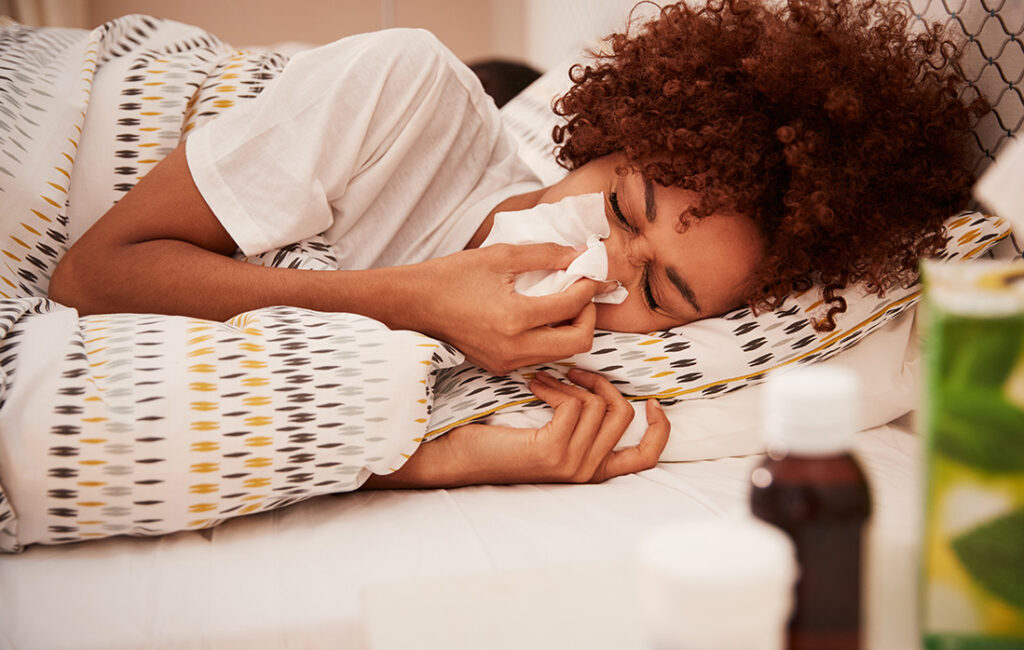
Struggling with a stuffy nose due to a cold, allergy problems, or a sinus condition really puts a damper on quality rest. Most of us toss and turn a lot, as there doesn’t seem to be a best sleeping position for sinus drainage that both frees our airways and helps us settle down to get the rejuvenating shuteye we need.
We talked with two experts who share ideas for not only how to sleep well with sinus issues, but also what you should be paying attention to during the day to minimize them, the best sleeping positions for sinus drainage, and when to seek medical help.
How Does Your Nose Affect Sleep?
The interconnectedness of our various body functions is truly amazing. For example, “breathing through the nose filters, humidifies, and warms the air for our lungs,” says Dr. Ofer Jacobowitz, a board-certified sleep medicine physician, co-director of Sleep, ENT and Allergy Associates, and associate professor of otolaryngology at the Zucker School of Medicine at Hofstra/Northwell University. He adds that nasal breathing also delivers nitric oxide to the lungs and improves lung ventilation and efficiency.
But when your sinus cavity is clogged and not draining well, this has a negative impact on breathing regulation and sleep, especially when caused by obstructive sleep apnea or nasal inflammation due to chronic obstructive pulmonary disease (COPD) and emphysema. Jacobowitz states that studies examine the effects of nasal obstruction, and on average, there are “10 times the rate of micro-arousals” when the nasal passages are blocked. This means your sleep is fragmented, which leads to more daytime impairment.
However, he adds that treatment of nasal obstruction resulted in more continuous rest with more REM and deep sleep. “This reflects what I’ve seen as an ENT surgeon, where patients often told me they’re dreaming more after nasal surgery, possibly due to the REM sleep effect.”
In what other ways does unobstructed nasal breathing enhance our sleep? It can reduce snoring, and Jacobowitz says another possible benefit is it “helps cool our brain at night by venting off heat produced by brain cell metabolism.”
Why Are My Sinuses Worse at Night?
Quite simply, “nighttime is when most of us lie flat,” says Dr. Christie Barnes, an assistant professor and residency program director of the Department of Otolaryngology—Head and Neck Surgery at the University of Nebraska Medical Center. Lying flat puts our head in a position directly in line with our heart and generally increases blood flow to the head. It’s not that lying down makes sinus drainage worse, but “when we sleep, it feels worse since we’re not upright and blowing our noses,” she says.
Barnes explains another function of the nose most of us aren’t aware of: an intranasal phenomenon called the “nasal cycle”, which she says is a process that occurs in varying lengths throughout the day and night. Here’s how it works:
- There are three pairs of “mucosa-lined bony structures” on the sides of your nose called turbinates, responsible for warming and humidifying air.
- The nasal cycle is when one side of the nose, specifically the turbinates, receives more blood flow than the other, which “increases the surface area of your nose and nasal lining to better warm and moisten the air in your nose as it makes its way to your lungs.”
- A normal nasal cycle allows this to happen so you can warm the air but not block off both sides of your nose at once. The turbinates have veins that expand and contract with this cycle.
If you’re trying to determine what side to lie on for sinus drainage, you might notice that one side has easier airflow for longer than the other. There’s a reason for this, too.
“When you lie with one side down, the dependent (down side) fills with blood, while the up side will decongest or shrink,” Barnes adds. “This makes up the majority of reasons why people can’t breathe at night and have to flip over to breathe better. Folks with anatomic narrowing—such as septal deviation or big turbinates at the baseline due to sinus problems or allergies—notice this much more than others with plenty of room in their nasal cavities.” It’s not that your sinuses are actually draining, she says, but more of a redistribution of blood flow.
What Else Causes Sinus-Related Sleep Trouble?
Jacobowitz says there are many other reasons for sinus congestion including, but not limited to:
- Nasal polyps, which the Mayo Clinic defines as noncancerous growths caused by “chronic inflammation and are associated with asthma, recurring infection, allergies, drug sensitivity or certain immune disorders.”
- Allergies, especially due to pets, during high pollen times, or—ew!—irritation to dust mites in the bedsheets and carpeting.
- Smoking or secondhand smoke exposure, which studies indicate leads to chronic rhinosinusitis, an inflammatory disorder of the sinuses and nasal passages.
- Alcohol intolerance also causes a stuffy or runny nose and facial flushing, especially if you’re allergic to certain ingredients in beer or wine.
- Very cold air, as “the nasal tissues swell to warm and humidify the air.”
- Pregnancy, because “the nose congests due to engorged blood vessels.”
He adds that certain medications can also cause congestion, including antihypertensives (beta blockers), oral contraceptives, medications for erectile dysfunction, prostate hypertrophy, ibuprofen, and some antidepressants. “Some people also become dependent on using sprays containing oxymetazoline that cause rebound severe congestion when overused,” he says.
The Best Sleeping Positions For Sinus Drainage
“Sinus drainage is not typically position dependent,” Barnes says. “But elevating your head off bed helps with stuffiness when you have a cold or allergy flare.”
Jacobowitz adds that “gravity rules,” so sleeping with your head more elevated as long as it’s comfortable is best. The worst sleeping position for sinus drainage is usually flat on your back. “Not only does the nose congest, but also for some [people], palate and throat obstruction occurs, so one feels a greater degree of obstruction at nose level.”
If being elevated doesn’t come naturally to you at first, a wedge pillow with a gradual incline might provide a bit of comfort for sinus drainage but not cause neck pain. Usually side sleepers choose a lower wedge, while people who lie predominantly on their backs choose a pillow with a 7”–12” rise.
Other Methods For Draining Sinuses
Your daytime habits make all the difference in the quality of your sleep hygiene, including keeping your sinuses clear.
Barnes suggests doing a sinus nasal rinse, using a saline solution to remove bacteria and irritants. Make sure to rinse a couple of hours before bedtime to avoid post-nasal drip, which might sound like the sinus drainage you’re hoping for but, according to the Cleveland Clinic, can cause other health problems such as hoarseness, bad breath, and nausea. She also recommends talking with an otolaryngologist (an ear, nose, and throat specialist) about prescribed nasal sprays that help clear out drainage and reduce swelling.
Jacobowitz adds that regular exercise “tones up the nasal blood vessels and improves airflow.” Also, do what you can to avoid smoke, allergens, and alcohol to improve nasal airways more consistently. He says that “eating dinner earlier — and having a lighter dinner — reduces reflux that can cause congestion” as well.
Should you rely on over-the-counter oral decongestants every night? Jacobowitz says no, as they’re not often as effective or safe as other methods. “If allergies are present, use of a HEPA device, and dust casings for the bed may help.” A bedroom humidifier might also keep nasal passages warm and moist.
Here are some other holistic remedies for sinus drainage:
- Take a hot shower or do a warm facial steam before bedtime.
- Speaking of increasing moisture, stay hydrated throughout the day. In addition to water-rich foods, Harvard School of Public Health recommends approximately 13 cups for adult men and 9 cups for adult women.
- As part of your light dinner, try a hot soothing soup or cup of tea. Or add a little something spicy, as a dash of the ingredient capsaicin thins mucus.
- Avoid caffeine after 2:00 p.m.
- Resist the urge to forcibly blow your nose — research suggests dabbing at it might be less invasive to nasal passages.
When to See a Specialist
If you’re experiencing chronic sinus issues and nothing seems to help — especially antihistamine or steroid sprays — it’s probably time to consult an otolaryngologist. Barnes says while a sinus infection (be it viral or bacterial) might be the most common problem, “allergies, irritants, hormones, and medications can increase drainage and — in very rare cases — a brain fluid leak.”
Jacobowitz says an otolaryngologist examines your entire upper airway to look for signs of inflammation, polyps, an irregular septum, and other rare conditions, such as tumors. They’ll also conduct allergy testing if necessary for better environmental management. If there is actual nasal obstruction, such as problems with the turbinates, polyps, or the need for nasal valve treatment, he says most physicians can perform in-office procedures to remedy the problem. “The key is not to ignore it,” he adds.
The Last Word From Sleepopolis
If you’re continually having trouble finding the best sleeping position for sinus drainage, start by examining your daily habits. It’s possible that eating too close to bedtime or a lack of exercise and hydration might be contributing to the problem. Also determine if your bedroom is free of potential irritants that are causing excessive stuffiness. Finally, if you’ve not tried an adjustable bed or pillow before, they might provide just the relief you need.


























